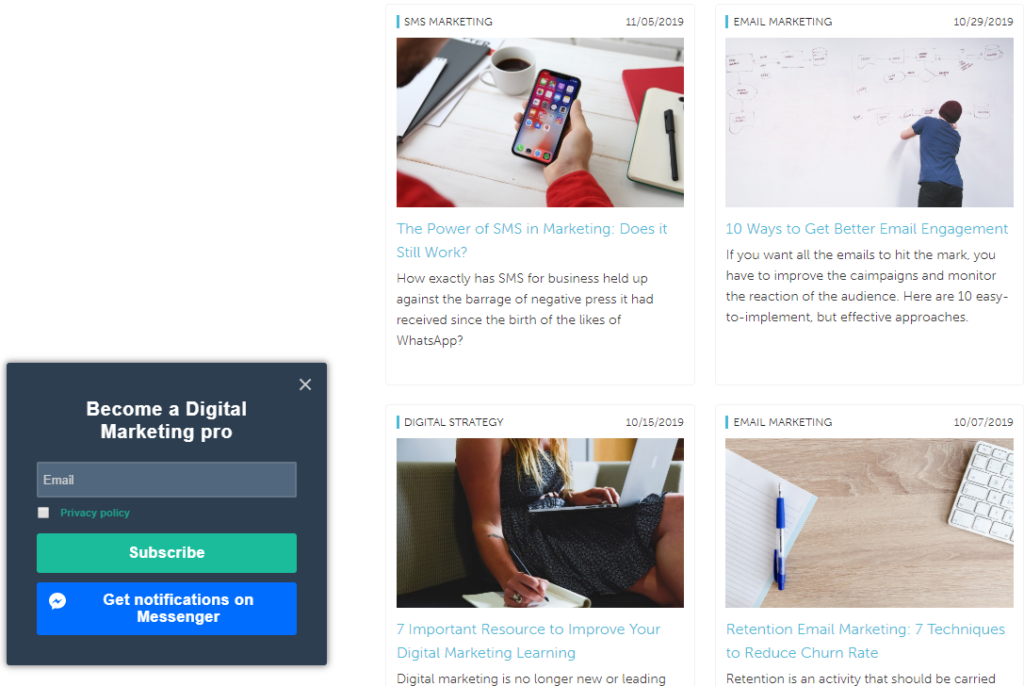Database Building: The 5 Commandments for Subscription Forms

Seth Godin coined the term Permission Marketing almost a decade ago, which means the set of strategies that have the goal of obtaining a consumers’ permission to communicate with them via personal, relevant messages in line with their wishes.
This principle finds its best application in email, where before completing a conversion or even simply reading a newsletter, explicit authorization from the recipient is required.
And this is brands’ testing ground: they must convince visitors to give their consent, and a simple “Sign up for my newsletter” is not enough, because users giving you their authorization are not simply offering you space in their inboxes, but are giving you their attention, which means time and motivation.
In short,this database-building activity is based on three fundamental moments:
- The registration proposal (different terms are used here, for example lead magnet, carrot content)
- The design, the layout, the UX
- The follow up.
Having said that, we will now take a look at the five principles that in our opinion must guide the creation of a registration form, whether it translates into a band on your website, a landing page, or a pop-up.

From developing integrations to strategic support, from creating creative concepts to optimizing results.
Value
Like in Content Marketing – and in general in everything relating to marketing – value is the hallmark of a proposal, be it a blog post, an offer, or like in our case, an invitation to subscribe to the newsletter.
The value doesn’t have to be a discount or a promotion, it can be a promise of value such as something useful, the ability to excite, or inspire with content.
In short, registration must be connected to an incentive for the recipient, a promise, and it can be more or less tangible, more or less concrete. This is the only way to induce a user to stay in touch with your brand and receive your communications in the future.
This doesn’t mean your proposal should get lost in vague and abstract promises: it must be focused on something that is very clear. We’ve chosen the most concrete promise for our example: that of a discount, which is always effective in marketing, especially in the e-commerce sector.

Immediacy
The invitation to register must not be something the user randomly encounters while browsing your website. On the contrary, it must be prominent, placed as a second level of reading the page, as the possibility of an advantage directly relating to the contents that the user is currently browsing.
In this regard, a pop-up turns out to be a very effective tool because it gives the subscription option its own space “above” the contents of the page, like a sort of sticker affixed to the site.
Here’s the pop-up we created for our blog:

Creating one is very simple: MailUp has a function that lets you build a pop-up form with just a few clicks. In addition to being ready for use, pop-ups are multi-channel: all you have to do is flag a box to automatically insert an email, SMS, or Messaging Apps field (or all three). You can also customize the pop-up by defining:
- Its style, depending on the dominant color on the page that will host it
- Position
- Language
- Header (for example “Receive discounts and promotions”)
- Subscription channels
- Link to the privacy policy.
Once you’ve created the pop-up, you’ll get the code to add to your site, blog, or any other type of page.
Double opt-in
This point has less to do with the proposal, and more with database building best practices. Double opt-in requires that a registration confirmation email is sent as soon as the user finishes filling in the form. This method ensures that the email address entered is valid and actually belongs to the user.
If you think single opt-in is more effective, you should know that double opt-in is better in the long run, especially if your goal is to build a database with a high involvement rate.
Here’s a summary of the main advantages ofdouble opt-in.
- Better engagement and willingness to purchase
Everyone who agrees to receiving your communications twice will demonstrate more interest in future campaigns and an increased likelihood of purchase and loyalty. - Less bounce, more deliverability
Through verifying the email addresses, the double opt-in system lets you minimize the bounce rate, which has a negative impact on many brands’ reputations and causes problems with deliverability. - Fewer spam reports
Like bounces, spam reports also affect reputation. The benefits of the double opt-in are also felt here. Not many recipients who complete a double confirmation for your communications will then report your email as spam.

Consistency
Remember when we talked about brand coherency and consistency? To remind you, they are a company’s ability to convey its own dimension, its visual identity in a constant way, and in every touchpoint. Since all of us consumers are habitual beings, we seek consistency, recognizability, which leads us to judge that brand as reliable. Conversely, people are very sensitive to inconsistencies: a survey conducted some time ago revealed that 41% of people consider brand consistency to be the most important factor for loyalty to a company.
Let’s get back to us: the brand consistency theory must also apply to registration forms, because making an element – in our case an invitation to subscribe – consistent and with uniform style requires the user’s trust.
Here’s a good example of brand consistency.This is the site page:

And this is the registration pop-up:

The two support each other and have similar graphics and style in the font, in the tones and colors, in the general layout (minimal and clean), and in the copy, where the promise of value is perfectly consistent with the page the user is visiting (the best newly released albums). This brings us to the next point.
Specificity
The consistency of content between a webpage and form is a fundamental aspect: whatever the offer that the form or pop-up is focusing on, that offer – and only that – must be somewhere on the page. In other words, it is important that the registration proposal focuses on an advantage, a promise that is clear, unambiguous, explicit, and as limited as possible.
Like we said in our first point, it is counterproductive to promise vague and indistinct advantages, or simply request to stay in touch. These proposals have no credibility, no added value.
There’s also a psychological reason behind this: as many know, in marketing people are turned off by too many choices. Like Barry Schwartz said, “There is a reduction in the potential for utility when there are so many alternatives; every new option takes something away from the previous proposal”.
The ratio between the registration form and objective should be 1:1. Every campaign has a goal, and in the same way every landing page and every registration form must convey only one call to action, a single proposal.
In summary
The opt-inform is a fundamental tool of database building, which in turn is a coreactivity of email marketing.
Our advice is to learn more about the topic and understand all the techniques that companies have available to convert browsers and users into new recipients for their campaigns. You can do it with MailUp: request a MailUp platform trial and explore the powerful simplicity of Database Building tools.